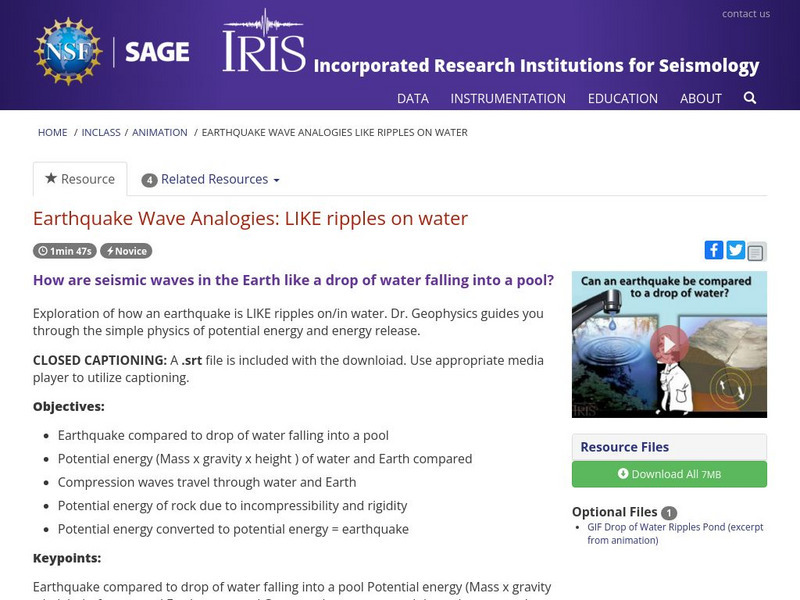Hi, what do you want to do?
Incorporated Research Institutions for Seismology
Iris: Solomon & Vanuatu Islands: Earthquakes & Tectonics
Islands in the south Pacific are recognized for particular features which nurture earthquakes. A video will illustrate tectonic microplates found in the region. [4:09]
Incorporated Research Institutions for Seismology
Iris: Subduction Zone: Tsunamis Generated by Megathrust Earthquakes
A video detailing the severe danger of megathrust earthquakes. These are known as the most powerful earthquakes on earth. [5:43]
Incorporated Research Institutions for Seismology
Iris: Sumatra: A Tale of Two Earthquakes
2004 and 2012 record two massive earthquakes in the same general geographic area occurred. Find out why the outcomes of both were so different. [4:38]
Incorporated Research Institutions for Seismology
Iris: Tectonics & Earthquakes of the Himalaya
Understand the role of the Himalayan plate boundary in the Nepal earthquake of 2015. How have the plates shifted over the years? Find additional resources to study this more. [6:32]
Incorporated Research Institutions for Seismology
Iris: Us Array Visualizations: Tutorial on Viewing
An introduction to understanding what USArray visualizations provide. Earthquake waves are captured and turned into a graphic video. [2:24]
Incorporated Research Institutions for Seismology
Iris: Volcano Monitoring: Measuring Magmatic Gas
Measuring magmatic gas emissions helps seismologists identify volcanoes which are ready to erupt. Check out this animated video illustrating the process. [1:24]
Incorporated Research Institutions for Seismology
Iris: Seismic Wave Behavior: A Single Boundary Refracts & Reflects
This introduction to seismic wave behavior describes Snell's Law and how it applies to layers in the earth. It addresses reflected, refracted, critically refracted, and head waves. Seismic waves travel at different speeds through...
Incorporated Research Institutions for Seismology
Iris: 4 Station Seismograph Network; No Cartoon House Bounce
Animation illustrates that seismic waves traveling away from an earthquake occur everywhere, not just at seismic stations. [0:21]
Incorporated Research Institutions for Seismology
Iris: Asperity on a Fault
Brief animation shows friction at an asperity along a right-lateral fault and explains why faults don't keep sliding past each other. [0:13]
Incorporated Research Institutions for Seismology
Iris: Basin & Range: Gps Measures Extension
Animation shows how GPS measures extension and that it is ongoing. [1:00]
Incorporated Research Institutions for Seismology
Iris: Elastic Rebound on High Friction Strike Slip Fault
Animation shows the buildup of stress along the margin of two stuck plates that are trying to slide past one another deforming rock. [33]
Incorporated Research Institutions for Seismology
Iris: Fault: Strike Slip
Strike-slip faults are vertical fractures where the blocks have mostly moved horizontally. This brief animation provides an illustration. [0:18]
Incorporated Research Institutions for Seismology
Iris: Magnitudes: Moment Magnitude Explained
Video clip provides a definition of moment magnitude and why it replaced the Richter Scale. [5:40]
Incorporated Research Institutions for Seismology
Iris: Travel Time Curves: How They Are Created
An animation which illustrates how the travel time of an earthquake is measured. What alters the velocity of the waves? [1:06]
Incorporated Research Institutions for Seismology
Iris: 4 Station Seismograph Network Records a Single Earthquake
Animation illustrates how seismic stations at varying distances from a large earthquake have signature seismograms. [0:31]
Incorporated Research Institutions for Seismology
Iris: Five Earthquakes Equidistant From One Seismograph Station
This animation uses a gridded sphere to show a single station recording five earthquakes equal distance away. [0:44]
Incorporated Research Institutions for Seismology
Iris: Layers of the Earth
This animation explores the 3 main layers of the Earth and tells how they were discovered, what they are, and how the crust differs from the tectonic (lithospheric) plates. [6:20]
Incorporated Research Institutions for Seismology
Iris: Alaska: Tectonics and Earthquakes
Alaskan tectonics are dominated by Pacific-North American plate interaction. This animation discusses the range of tectonic activity from megathrust earthquakes to accretion of geologic terranes. [8:40]
Incorporated Research Institutions for Seismology
Iris: Alaska: The Great Alaska Earthquake of 1964
The 1964 Great Alaska Earthquake occurred on Good Friday, March 27th. Liquefaction in and around Anchorage tore the land apart and was the second largest quake ever recorded by seismometers. This animation shows the underlying causes and...
Incorporated Research Institutions for Seismology
Iris: Building Resonance: The Resonant Frequency of Different Seismic Waves
Why do some buildings fall in earthquakes? Animated video addresses the key points of frequency, period, and resonance. All buildings have a natural, period, or resonance, which is the number of seconds it takes for the building to...
Incorporated Research Institutions for Seismology
Iris: Buildings & Bedrock: Effects of Amplification & Liquefaction
Animation explores how 3 buildings engineered equally on different bedrock will react to an earthquake. [1:25]
Incorporated Research Institutions for Seismology
Iris: Earthquake Machine: Graphing Time vs. Distance
This animation shows the change in distance over time as the Earthquake Machine overcomes friction and jumps during an "earthquake". [0:24]
Incorporated Research Institutions for Seismology
Iris: Earthquake Machine: Graphing Time vs. Strain
Animation illustrates the buildup and release of strain in locked and slow slip zones. [0:28]
Incorporated Research Institutions for Seismology
Iris: Earthquake Wave Analogies: Like Ripples on Water
In this animation, Dr. Geophysics compares seismic waves to ripples in water and helps explain how they are alike. He also guides you through the simple physics of potential energy and energy release. [1:47]




























